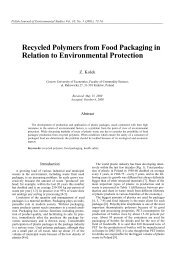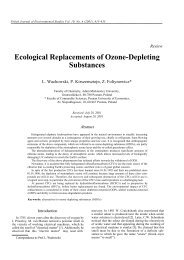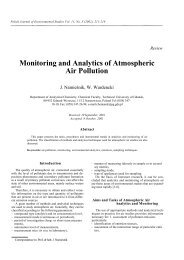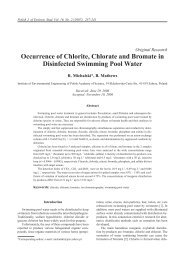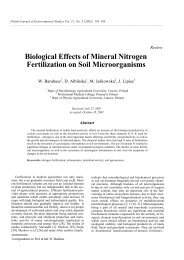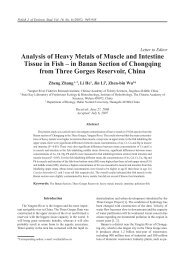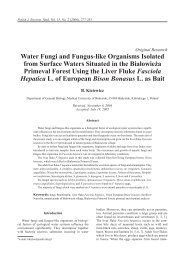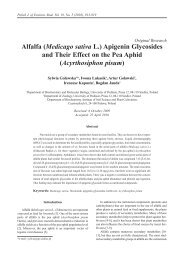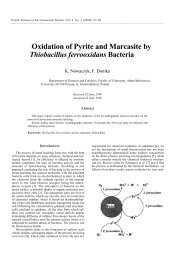The Effect of Metal Ions on Mortality, Pathogenicity and ...
The Effect of Metal Ions on Mortality, Pathogenicity and ...
The Effect of Metal Ions on Mortality, Pathogenicity and ...
Create successful ePaper yourself
Turn your PDF publications into a flip-book with our unique Google optimized e-Paper software.
Polish Journal <str<strong>on</strong>g>of</str<strong>on</strong>g> Envir<strong>on</strong>mental Studies Vol. 11, No. 5 (2002), 517-519<br />
<str<strong>on</strong>g>The</str<strong>on</strong>g> <str<strong>on</strong>g>Effect</str<strong>on</strong>g> <str<strong>on</strong>g>of</str<strong>on</strong>g> <str<strong>on</strong>g>Metal</str<strong>on</strong>g> <str<strong>on</strong>g>I<strong>on</strong>s</str<strong>on</strong>g> <strong>on</strong> <strong>Mortality</strong>,<br />
<strong>Pathogenicity</strong> <strong>and</strong> Reproducti<strong>on</strong> <str<strong>on</strong>g>of</str<strong>on</strong>g><br />
Entomopathogenic Nematodes Steinernema<br />
feltiae Filipjev {Rhabditida, Steinernematidae)<br />
M. Jaworska, A. Gorczyca<br />
Department <str<strong>on</strong>g>of</str<strong>on</strong>g> Agricultural Envir<strong>on</strong>ment Protecti<strong>on</strong><br />
Agricultural University <str<strong>on</strong>g>of</str<strong>on</strong>g> Kraków, Al. Mickiewicza 21; 31-120 Kraków, Pol<strong>and</strong>,<br />
E-mail: rrwisnie@cyf-kr.edu.pl<br />
Received: 10 January, 2002<br />
Accepted: 26 March, 2002<br />
Abstract<br />
<str<strong>on</strong>g>The</str<strong>on</strong>g> effect <str<strong>on</strong>g>of</str<strong>on</strong>g> cadmium, copper, lead, zinc, manganese <strong>and</strong> magnesium <strong>on</strong> entomopathogenic nematodes<br />
S. feltiae was tested under laboratory c<strong>on</strong>diti<strong>on</strong>s. <str<strong>on</strong>g>The</str<strong>on</strong>g> mortality <str<strong>on</strong>g>of</str<strong>on</strong>g> nematode invasive larvae, their<br />
pathogenicity expressed as test insect G. mell<strong>on</strong>ella mortality <strong>and</strong> reproducti<strong>on</strong> from the test insect bodies<br />
were investigated. It was revealed that cadmium, copper, lead <strong>and</strong> zinc affected an increase <str<strong>on</strong>g>of</str<strong>on</strong>g> S. feltiae<br />
nematode invasive larvae mortality, decreased their pathogenicity for test insects <strong>and</strong> reproducti<strong>on</strong>. Manganese<br />
in 400 mgdm 3 Mn (II) c<strong>on</strong>centrati<strong>on</strong> positively affected entomopahogenic nematode S.feltiae during<br />
their storage causing decreased mortality, improved pathogenicity <strong>and</strong> reproducti<strong>on</strong> from insect bodies in<br />
comparis<strong>on</strong> to distilled water.<br />
Keywords: metal i<strong>on</strong>s, entomopathogenic nematodes, S.feltiae, mortality, pathogenicity, reproducti<strong>on</strong>.<br />
Introducti<strong>on</strong><br />
Invasive larvae <str<strong>on</strong>g>of</str<strong>on</strong>g> entomopathogenic nematodes actively<br />
or passively penetrate into the bodies <str<strong>on</strong>g>of</str<strong>on</strong>g> insects<br />
through natural apertures or cuticles <strong>and</strong> thus are c<strong>on</strong>sidered<br />
<strong>on</strong>e <str<strong>on</strong>g>of</str<strong>on</strong>g> the most efficient microorganisms used for<br />
biological crop protecti<strong>on</strong> [1]. Representatives <str<strong>on</strong>g>of</str<strong>on</strong>g> several<br />
nematode families are used for insect pest c<strong>on</strong>trol [2, 3].<br />
Species from Steinernematidae <strong>and</strong> Heterorhabditidae<br />
(Nematoda: Rhabditida) families are most important.<br />
<str<strong>on</strong>g>The</str<strong>on</strong>g> species most frequent in the natural envir<strong>on</strong>ment in<br />
Pol<strong>and</strong> are Steinernema carpocapsae, S. feltiae <strong>and</strong> Het-<br />
erorhabditis bacteriophora. Advantages <str<strong>on</strong>g>of</str<strong>on</strong>g> nematodes as<br />
biopreparati<strong>on</strong>s include the wide range <str<strong>on</strong>g>of</str<strong>on</strong>g> their host<br />
insects, ability for fast insect killing, fast breeding, no<br />
immunizati<strong>on</strong> <str<strong>on</strong>g>of</str<strong>on</strong>g> pests <strong>and</strong> no hazard for the envir<strong>on</strong>ment<br />
or higher animals, as well as a possibility <str<strong>on</strong>g>of</str<strong>on</strong>g> storing<br />
material used for infecti<strong>on</strong> <strong>and</strong> its easy applicati<strong>on</strong>. Entomopathogenic<br />
nematode pathogenicity is c<strong>on</strong>diti<strong>on</strong>ed<br />
by such factors as temperature, soil moisture, soil structure<br />
<strong>and</strong> oxygen c<strong>on</strong>tent. This investigati<strong>on</strong> aimed at determining<br />
the effect <str<strong>on</strong>g>of</str<strong>on</strong>g> selected heavy metal i<strong>on</strong>s <strong>and</strong><br />
manganese <strong>and</strong> magnesium <strong>on</strong> vitality, pathogenicity <strong>and</strong><br />
reproducti<strong>on</strong> <str<strong>on</strong>g>of</str<strong>on</strong>g> S. feltiae entomopathogenic nematodes.<br />
Corresp<strong>on</strong>dence to: Pr<str<strong>on</strong>g>of</str<strong>on</strong>g>. M. Jaworska
518<br />
Experimental Procedures<br />
S. feltiae, as the most comm<strong>on</strong> species in the soils <str<strong>on</strong>g>of</str<strong>on</strong>g><br />
Pol<strong>and</strong>, was selected for the experiment. <str<strong>on</strong>g>The</str<strong>on</strong>g> strain came<br />
from the collecti<strong>on</strong> <str<strong>on</strong>g>of</str<strong>on</strong>g> the Institute <str<strong>on</strong>g>of</str<strong>on</strong>g> Plant Protecti<strong>on</strong> in<br />
Poznan, it was earlier acquired in the Wielkopolska regi<strong>on</strong><br />
<strong>and</strong> marked with PL II symbol. It was passaged <strong>on</strong><br />
G. mell<strong>on</strong>ella L. caterpillars using comm<strong>on</strong>ly accepted<br />
methods <strong>and</strong> stored in cold storage in 0.01% formaldehyde<br />
soluti<strong>on</strong> until the outset <str<strong>on</strong>g>of</str<strong>on</strong>g> the experiment. During<br />
the experiment toxicity <str<strong>on</strong>g>of</str<strong>on</strong>g> individual heavy metal salts<br />
was tested separately <strong>and</strong> then jointly with manganese or<br />
magnesium salts. <str<strong>on</strong>g>The</str<strong>on</strong>g> following salts were used: 75<br />
mg·dm -3 Cd(II) <str<strong>on</strong>g>of</str<strong>on</strong>g> cadmium chloride CdCl 2 , 7.5 mg·dm -3<br />
Cu(II) <str<strong>on</strong>g>of</str<strong>on</strong>g> copper sulphate CuSO 4·5H 2 O, 200 mg·dm -3<br />
Pb(II) <str<strong>on</strong>g>of</str<strong>on</strong>g> lead nitrate Pb(NO 3 ) 2 , 200 mg·dm -3 Zn(II) <str<strong>on</strong>g>of</str<strong>on</strong>g><br />
zinc chloride ZnCl 2 , 400 mg·dm -3 Mn(II) <str<strong>on</strong>g>of</str<strong>on</strong>g> manganese<br />
sulphate MnSO 4·5H 2 O <strong>and</strong> 160 mg·dm -3 Mg(II) <str<strong>on</strong>g>of</str<strong>on</strong>g> magnesium<br />
sulphate MgSO 4·7 H 2 O.1 ml <str<strong>on</strong>g>of</str<strong>on</strong>g> water soluti<strong>on</strong>s <str<strong>on</strong>g>of</str<strong>on</strong>g><br />
individual salts or a mixture <str<strong>on</strong>g>of</str<strong>on</strong>g> cadmium, copper, lead<br />
<strong>and</strong> zinc with manganese or magnesium salt were pipetted<br />
into 2 ml sterile vessels placed in Petri dishes. Distilled<br />
water was used in the c<strong>on</strong>trol object. About 50<br />
specimens <str<strong>on</strong>g>of</str<strong>on</strong>g> 5. feltiae invasive larvae were introduced<br />
into the vessels. <str<strong>on</strong>g>The</str<strong>on</strong>g> experiment included 5 replicati<strong>on</strong>s.<br />
<str<strong>on</strong>g>The</str<strong>on</strong>g> nematodes were kept at 20-22°C for 96 hours. Afterwards<br />
mortality rate <str<strong>on</strong>g>of</str<strong>on</strong>g> invasive larvae was assessed by<br />
counting dead specimens in the experimental objects.<br />
<str<strong>on</strong>g>Metal</str<strong>on</strong>g> i<strong>on</strong> effect <strong>on</strong> S. feltiae nematode pathogenicity was<br />
tested <strong>on</strong> G. mell<strong>on</strong>ella caterpillars. <str<strong>on</strong>g>The</str<strong>on</strong>g> dishes were incubated<br />
at 20-22°C for 4 days <strong>and</strong> then mortality rate <str<strong>on</strong>g>of</str<strong>on</strong>g><br />
the test insects was estimated. Dead insects were put <strong>on</strong><br />
watch glasses placed in Petri dishes filled with distilled<br />
water in order to determine S. feltiae nematode progeny<br />
producti<strong>on</strong> from the test insects. Live S. feltiae nematode<br />
invasive larvae migrating into the water were decanted<br />
<strong>and</strong> their total number was counted under binocular<br />
magnifying glass. <str<strong>on</strong>g>The</str<strong>on</strong>g> obtained results were then subjected<br />
to statistical evaluati<strong>on</strong> using single factor analysis <str<strong>on</strong>g>of</str<strong>on</strong>g><br />
variance <strong>and</strong> means were differentiated by Duncan test<br />
at the significance level p = 0.05.<br />
Results<br />
<strong>Mortality</strong>, pathogenicity <strong>and</strong> reproducti<strong>on</strong> <str<strong>on</strong>g>of</str<strong>on</strong>g> S. feltiae<br />
nematodes observed in the experiment after 96-hour c<strong>on</strong>tact<br />
with selected metal i<strong>on</strong>s <strong>and</strong> their mixtures with<br />
manganese or magnesium are presented in Table 1. Only<br />
in 400 mg-dm" 3 manganese salt soluti<strong>on</strong> was visibly lower<br />
nematode mortality was observed in comparis<strong>on</strong> with<br />
mortality <str<strong>on</strong>g>of</str<strong>on</strong>g> nematodes kept in distilled water. Mixtures<br />
<str<strong>on</strong>g>of</str<strong>on</strong>g> Cu+Mn <strong>and</strong> Pb+Mg had a similar, i.e. neutral effect<br />
<strong>on</strong> the nematodes as distilled water itself (c<strong>on</strong>trol). <str<strong>on</strong>g>The</str<strong>on</strong>g><br />
other soluti<strong>on</strong>s used in the experiment caused increased<br />
nematode mortality rates in comparis<strong>on</strong> with the c<strong>on</strong>trol<br />
in water (Figure 1), so they revealed toxic effects, the<br />
most apparent for lead <strong>and</strong> Cd+Mn <strong>and</strong> Cu+Mg mixtures.<br />
<str<strong>on</strong>g>The</str<strong>on</strong>g> influence <str<strong>on</strong>g>of</str<strong>on</strong>g> selected metal i<strong>on</strong>s <strong>on</strong> S. feltiae<br />
nematode pathogenicity for the tested caterpillars in relati<strong>on</strong><br />
to c<strong>on</strong>trol is shown in Figure 2. S. feltiae<br />
nematodes from cadmium, copper, lead <strong>and</strong> zinc mixtures<br />
with manganese or magnesium <strong>and</strong> after their c<strong>on</strong>-<br />
Table 1. <str<strong>on</strong>g>Effect</str<strong>on</strong>g> <str<strong>on</strong>g>of</str<strong>on</strong>g> heavy metals <strong>and</strong> heavy metal mixtures with<br />
manganese <strong>and</strong> magnesium <strong>on</strong> mortality <strong>and</strong> pathogenicity expressed<br />
as test insect mortality, <strong>and</strong> <strong>on</strong> reproducti<strong>on</strong> <str<strong>on</strong>g>of</str<strong>on</strong>g> S. feltiae<br />
entomopathogenic nematodes.<br />
* Means marked by the same letters in columns do not differ<br />
statistically at the significance level p = 0.05<br />
tact with lead had decreased abilities to infect the test<br />
insects, even if the activity <str<strong>on</strong>g>of</str<strong>on</strong>g> the menti<strong>on</strong>ed metals did<br />
not previously cause any marked nematode mortality in<br />
comparis<strong>on</strong> with the c<strong>on</strong>trol. After c<strong>on</strong>tact with the other<br />
single metal i<strong>on</strong>s (Cd, Cu, Mg, Zn) S. feltiae nematodes<br />
infected the test insects similarly as those from distilled<br />
water, whereas manganese improved pathogenic abilities<br />
<str<strong>on</strong>g>of</str<strong>on</strong>g> invasive S. feltiae nematode larvae as compared with<br />
the c<strong>on</strong>trol. Entomopathological nematode progeny producti<strong>on</strong><br />
from the test insects compared to c<strong>on</strong>trol is<br />
shown in Figure 3. Manganese slightly stimulated S. feltiae<br />
reproducti<strong>on</strong> in comparis<strong>on</strong> with the c<strong>on</strong>trol. 5. feltiae<br />
nematodes reproduced worst after c<strong>on</strong>tact with copper<br />
<strong>and</strong> zinc, <strong>and</strong> also following their c<strong>on</strong>tact with zinc<br />
<strong>and</strong> magnesium mixture. <str<strong>on</strong>g>The</str<strong>on</strong>g> number <str<strong>on</strong>g>of</str<strong>on</strong>g> invasive larvae<br />
obtained from 1 mg <str<strong>on</strong>g>of</str<strong>on</strong>g> test insect body for the combinati<strong>on</strong><br />
was approximate.<br />
Discussi<strong>on</strong> <str<strong>on</strong>g>of</str<strong>on</strong>g> Results<br />
Jaworska M., Gorczyca A.<br />
For the tested S. feltiae nematodes metal i<strong>on</strong>s <str<strong>on</strong>g>of</str<strong>on</strong>g> lead,<br />
cadmium <strong>and</strong> copper proved toxic. In the lead salt soluti<strong>on</strong><br />
even five times higher nematode mortality was noticed<br />
in comparis<strong>on</strong> with the c<strong>on</strong>trol. C<strong>on</strong>tact with lead<br />
also c<strong>on</strong>siderably decreased the nematode pathogenicity<br />
for the tested insects <strong>and</strong> nematode reproducti<strong>on</strong> in the
<str<strong>on</strong>g>The</str<strong>on</strong>g> <str<strong>on</strong>g>Effect</str<strong>on</strong>g> <str<strong>on</strong>g>of</str<strong>on</strong>g> <str<strong>on</strong>g>Metal</str<strong>on</strong>g> <str<strong>on</strong>g>I<strong>on</strong>s</str<strong>on</strong>g> ...<br />
519<br />
Fig. 1. <str<strong>on</strong>g>Effect</str<strong>on</strong>g> <str<strong>on</strong>g>of</str<strong>on</strong>g> heavy metal i<strong>on</strong>s <strong>and</strong> their mixtures with manganese<br />
or magnesium <strong>on</strong> S. feltiae mortality as compared to the<br />
c<strong>on</strong>trol (100%).<br />
Fig. 2. <str<strong>on</strong>g>Effect</str<strong>on</strong>g> <str<strong>on</strong>g>of</str<strong>on</strong>g> heavy metal i<strong>on</strong>s <strong>and</strong> their mixtures with manganese<br />
or magnesium <strong>on</strong> S. feltiae pathogenicity in % <str<strong>on</strong>g>of</str<strong>on</strong>g> test insect<br />
mortality as compared to the c<strong>on</strong>trol (100%).<br />
Fig. 3. <str<strong>on</strong>g>Effect</str<strong>on</strong>g> <str<strong>on</strong>g>of</str<strong>on</strong>g> heavy metal i<strong>on</strong>s <strong>and</strong> teir mixtures with manganese<br />
or magnesium <strong>on</strong> S. feltiae reproducti<strong>on</strong> as compared to the<br />
c<strong>on</strong>trol (100%).<br />
host body. While testing the effect <str<strong>on</strong>g>of</str<strong>on</strong>g> lead i<strong>on</strong>s <strong>on</strong> S.<br />
feltiae <strong>and</strong> Heterorhabditis megidis entomopathogenic<br />
nematodes Jarmul <strong>and</strong> Kami<strong>on</strong>ek [4] observed high mor-<br />
tality <strong>and</strong> decreased invasiveness in relati<strong>on</strong> to the test<br />
insects. During their research <strong>on</strong> the effect <str<strong>on</strong>g>of</str<strong>on</strong>g> metal i<strong>on</strong>s<br />
<strong>on</strong> Steinemema carpocapsae Jaworska et al. [5] found<br />
that lead, zinc <strong>and</strong> copper i<strong>on</strong>s were toxic for them. In<br />
the presented study manganese revealed stimulating effect<br />
<strong>on</strong> S. feltiae. Jaworska <strong>and</strong> Gorczyca [6] observed<br />
a similarly positive effect <strong>on</strong> other entomopathogenic<br />
nematodes. In the presented research both manganese<br />
<strong>and</strong> magnesium neutralized a negative effect <str<strong>on</strong>g>of</str<strong>on</strong>g> lead <strong>on</strong><br />
S. feltiae mortality. However, they did not neutralize the<br />
adverse lead effect <strong>on</strong> these nematodes pathogenicity.<br />
Jaworska <strong>and</strong> Ropek [7] observed much more positive<br />
reacti<strong>on</strong> <str<strong>on</strong>g>of</str<strong>on</strong>g> S. carpocapsae <strong>and</strong> Heterorhabditis bacteriophora<br />
to heavy metal i<strong>on</strong> interacti<strong>on</strong>s with manganese<br />
or magnesium. In the experiment discussed in the paper<br />
manganese revealed protective activity towards copper.<br />
Manganese <strong>and</strong> cadmium interacti<strong>on</strong>s had a toxic effect<br />
<strong>and</strong> influenced 5. feltiae mortality, their pathogenicity<br />
<strong>and</strong> progeny producti<strong>on</strong>. Magnesium did not neutralize<br />
the toxic effect <str<strong>on</strong>g>of</str<strong>on</strong>g> cadmium <strong>on</strong> 5. feltiae, either.<br />
In c<strong>on</strong>clusi<strong>on</strong> it may be stated that in vitro tests carried<br />
out in a laboratory revealed that cadmium, copper,<br />
lead <strong>and</strong> zinc affect an increase in mortality <str<strong>on</strong>g>of</str<strong>on</strong>g> S. feltiae<br />
invasive larvae, decrease their pathogenicity for the test<br />
insects <strong>and</strong> reproducti<strong>on</strong>. In 400 mg·dm -3 c<strong>on</strong>centrati<strong>on</strong><br />
manganese Mn(II) positively affected S. feltiae entomopathogenic<br />
nematodes during their storage, caused<br />
a decrease in their mortality rate, improved pathogenicity<br />
<strong>and</strong> reproducti<strong>on</strong> rate from the insect bodies in comparis<strong>on</strong><br />
with those kept in distilled water.<br />
References<br />
1. BEDDING R. A, MOLYNEUX A. S. Penetrati<strong>on</strong> <str<strong>on</strong>g>of</str<strong>on</strong>g> insect<br />
cuticule by infective juveniles <str<strong>on</strong>g>of</str<strong>on</strong>g> Heterorhabditis ssp. (Heterorhabditidae:<br />
Nematoda). Nematologica 28, 354, 1982.<br />
2. BRZESKI M., SANDNER H. Zarys nematologii. PWRiL<br />
Warszawa pp. 400, 1974.<br />
3. POINAR G. O. Nematodes for biological c<strong>on</strong>trol <str<strong>on</strong>g>of</str<strong>on</strong>g> insects.<br />
CRC Press Inc., Boca Rat<strong>on</strong>, Fla. pp. 277, 1979.<br />
4. JARMUL J., KAMIONEK M. <str<strong>on</strong>g>Effect</str<strong>on</strong>g> <str<strong>on</strong>g>of</str<strong>on</strong>g> Pb(II) i<strong>on</strong>s <strong>on</strong> mor<br />
tality <str<strong>on</strong>g>of</str<strong>on</strong>g> the Ijs Steinemema feltiae i Heterorhabditis megidis.<br />
Chem. Inz. Ekol. 7 (10), 1023, 2000.<br />
5. JAWORSKA M., SEPIOL J., TOMASIK P. <str<strong>on</strong>g>Effect</str<strong>on</strong>g> <str<strong>on</strong>g>of</str<strong>on</strong>g> metal<br />
i<strong>on</strong>s under laboratory c<strong>on</strong>diti<strong>on</strong>s <strong>on</strong> the entomopathogenic<br />
Steinemema carpocapsae {Rhabditida: Steinemematidae).<br />
Water Air Soil Poll. 88, 331, 1996.<br />
6. JAWORSKA M., GORCZYCA A. <str<strong>on</strong>g>Effect</str<strong>on</strong>g> <str<strong>on</strong>g>of</str<strong>on</strong>g> manganese<br />
i<strong>on</strong>s <strong>on</strong> entomopathogenic nematodes. Entom<strong>on</strong>ematologia<br />
2 (4), 1, 1993.<br />
7. JAWORSKA M., ROPEK D. Mozliwosc podwyzszania patogenicznosci<br />
i reprodukcji owadobojczych nicieni przez j<strong>on</strong>y<br />
metali. Mat. z II K<strong>on</strong>f. Nauk. Krakow: ,,Oddzialywanie<br />
j<strong>on</strong>ow metali na mikroorganizmy": 47, 1997.



